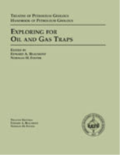Pressure prediction: analysis of mud weights
| It has been suggested that this article be merged with [[::Pressure prediction|Pressure prediction]]. (Discuss) |
| Exploring for Oil and Gas Traps | |

| |
| Series | Treatise in Petroleum Geology |
|---|---|
| Part | Critical elements of the petroleum system |
| Chapter | Formation fluid pressure and its application |
| Author | Edward A. Beaumont, Forrest Fiedler |
| Link | Web page |
| Store | AAPG Store |
Mud weight and pore pressure
The mud weight needed to control a well reflects pore pressure of any permeable formations drilled. To control a well, operators generally use a mud weight that will exert a pressure close to the expected pore pressure. When drilling mud kicks or blows out, the pressure from the mud is less than, but usually close to, pore pressure.
Calculating pressure from mud weight
When the drilling mud kicks or blows out, pore pressure can be calculated by using the following formula:
For example, if a 7500-ft-deep hole contains mud with a weight of 10.5 ppg, then the pore pressure at the bottom of the hole is 4095 psi or more.
Accuracy
This method's accuracy mainly depends on estimates of mud weight. The accuracy of mud weight estimates, measured periodically from the mud pits at the well site, is affected by three factors:
- Formation water and gas cutting of the mud
- Entrapment of air at the surface
- Long circulation periods of the mud
A difference of 0.1 ppg in mud weight can cause an error of 500 psi at depth::10,000 ft in the estimate of pore pressure.
Problems with interpreting pressure from mud weight
Different operators have different policies about how much margin to allow between formation pore pressure and mud pressure; the range in margin is quite large. Also, the well bore can penetrate a pressure seal for many hundreds of feet without penetrating a permeable zone, in which case mud weight may not reflect the presence of abnormal pressure below the seal. In general, mud weight should be a clue to be confirmed by other evidence.
Mud weight in overpressured formations
In overpressured formations, normal mud weight will not offset formation pressure. If mud weight is increased, however, it can break down (fracture) the normally pressured formations higher in the hole. High pressure requires higher-than-normal mud weight, but the actual weight used might have been more than necessary (i.e., the formation pressure might not be as high as the mud weight implies).
Mud weight in underpressured formations
If significant underpressure is found, such that the formation breaks down (fractures and takes mud), the condition is noted in the drilling record. In underpressured formations, normal mud weight can fracture the formation. If the weight is decreased, however, fluid can flow into the well bore from uphole formations.
See also
- Pressure prediction: reconstructing burial history
- Pressure prediction: analysis of cuttings
- Pressure prediction: analysis of well-log and seismic data
- Abnormal hydrostatic pressure
